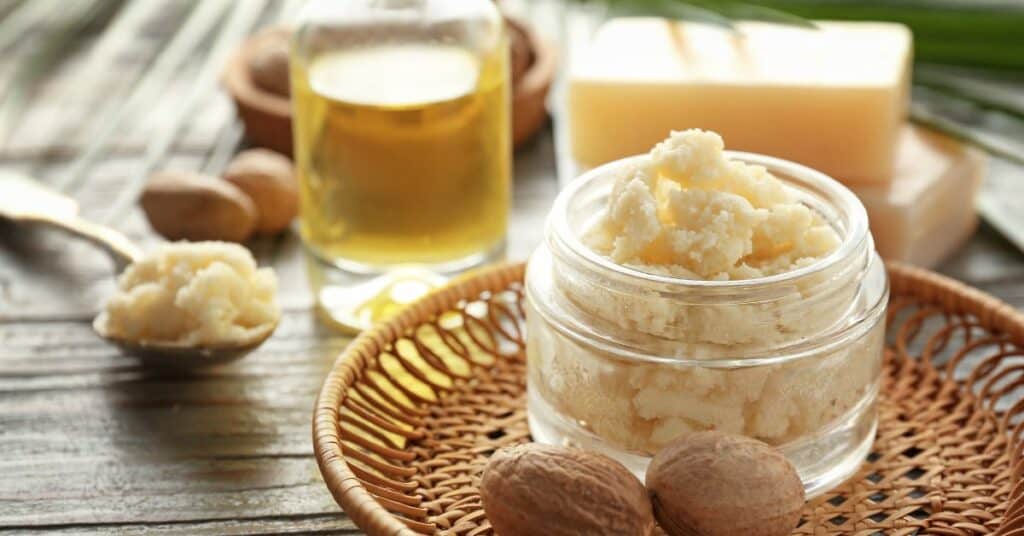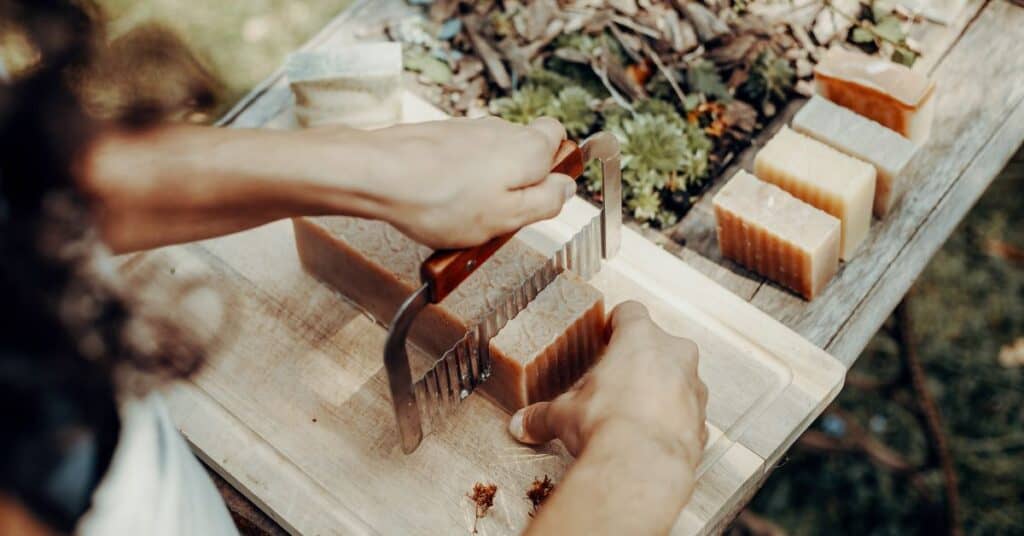Table of Contents
- What Does Superfat In Soap Mean?
- Why Is Superfatting Important?
- What Does Superfatting Do to Soap?
- Is There Any Such Thing As A True Superfat?
- Does It Work To Add Extra Superfatting Oils To Cold-Process Soap Recipes?
- How Much Superfat Or Lye Discount Do We Need For Our Soap Recipe?
- Conclusion
What is superfat? Superfat is an excess of oils and butter in a finished bar of soap that has not been saponified and turned into soap.
In other words, it is the amount of oil in a soap recipe that is not consumed by the lye during the saponification process.
So, every oil or combination of oils you use in a soap recipe has a different saponification value.
Depending on the fatty acid profiles of each of those oils or the particular oil you use.
In this blog, I will explain all you need to know about Superfatting.
What Does Superfat In Soap Mean?
In superfatting my soap recipe, I’m not actually adding extra oil to my recipe. What I’m actually doing is reducing the lye amount in the recipe.
If you know what I’m talking about and are familiar with the soap recipe calculator, usually, they will have a section where it says super fat.
And you tell the soap calc the percentage of superfat you want in your soap.
What that’s doing is, for example, 5% superfat. That’s a standard superfat rate.
That’s not telling us that the soap recipe is going to have 5% excess oil in it.
What it’s effectively doing is reducing the amount of lye in the soap.
So we’re actually discounting the lye in the soap recipe to give us an excess amount of oils.
Soap Calc isn’t adding an extra amount of oil to Your recipe.
Instead, it’s reducing the amount of sodium hydroxide or potassium hydroxide to give that oil excess in the recipe.
An Example of Superfat in Soap Making is if you put that 1000 grams.
base oil amount into the soap calculator, and you put your 5% superfat amount in the superfat percentage box,
you will notice that when you calculate the recipe and view the final recipe
The soap calculator has calculated for you; you will see that the overall oil amount has not increased by another 5%.
Instead, you will still see 1000 grams of oil in total. It might be different types of oils, but they will still be the original oil base amount that you put in.
You won’t see it because Soapcalc has done the calculation for you.
But the lye amount will be smaller than it Would have been if there was no superfat in your recipe.
Why Is Superfatting Important?
Now, superfatting? Excess amount of oil? What that does is really two things. It creates a safety margin.
It requires a very particular amount of lye to turn that amount of oil with those particular fatty acid profiles into soap.
So if you have excess oil in the soap recipe and the recipe only needs a particular amount of lye, when you combine those, then that’s
going to create a little bit of unsaponified oil in the soap, which
Makes sure that all of the lye is used up because we want to avoid having excess lye in our soap.
Excess lye is caustic, corrosive, and dangerous.
The second reason why we use a superfat or an excess amount of oil in the soap recipe is to make the soap a little bit milder.
Some soaps, depending on their fatty acid profiles and the type of soap, can be harsh on the skin.
A 100% coconut oil soap is a great example with low or no superfat, has a very high cleansing value, and can be very drying to the skin.
Adding a high amount of superfat to that kind of soap really makes it milder.
So there’s a lot of excess unsaponified oils in that soap, and it makes
It more gentle on the skin because there’s actually free oil left over in the soap.
What Does Superfatting Do to Soap?
Increased Moisturization
By leaving unreacted fats or oils in the soap, Superfatting ensures that these ingredients are available to hydrate and nourish your skin.
This leads to soap bars that are gentle and moisturizing, perfect for those with dry or sensitive skin.
Enhanced Cleansing
Superfatting doesn’t compromise the soap’s cleansing abilities.
Instead, it strikes a balance, offering effective cleansing without stripping the skin of its natural oils, which makes Superfatted soaps suitable for all skin types.
Rich Lather
The presence of excess fats or oils contributes to a creamy and luxurious lather when you use a Superfatted soap.
Is There Any Such Thing As A True Superfat?
The only time it will be a true superfat would be in the example of hot Process Soap makers.
Some hot process soap makers use a true superfat in that they physically add some extra fats or oil at the end of the cooking process.
It might be a particular oil that they want the qualities of in their soap as a superfat.
They add it after the soap is fully saponified. Because in hot process soap, you are forcing the reaction.
So the soap goes through all those changes, so you can test that it’s saponified first, and then you can add the superfat.
And there is a bit of debate on that. Personally, don’t bother with that in my hot process soap.
I just calculate the lye discount version of the superfat as I do with my cold processed recipe.
Does It Work To Add Extra Superfatting Oils To Cold-Process Soap Recipes?
Adding your superfat or excess oil amount in cold process soap.
It doesn’t make any difference. It is of no benefit to keep a particular oil aside in a cold process soap recipe after you have reached trace.
(Trace refers to a specific stage in the soap-making process when the soap batter has thickened to the consistency you want.)
In a cold process soap, when you mix your lye water solution and oil, You bring your soap batter to a trace; the saponification has just begun.
It is nowhere near complete, so by separating your little superfat oil and adding that after the soap has traced, you are just mixing it in with
All other oils, and together all of them will be saponified by the lye to make soap.
How Much Superfat Or Lye Discount Do We Need For Our Soap Recipe?
Is 10% Superfat Too Much? That‘s a million-dollar question!
While a Superfat percentage of 10% may seem high, it’s essential to
Recognize that the suitability of this percentage depends on the specific recipe, the fatty acids that make up your oils, and your skin’s needs.
It’s crucial to note that a higher superfat percentage can make the
soap bar feels softer, causes spoilage, reduces its lather, and leads to DOS (dreaded orange spot)
Some people always super-fat their soap to 8% or a higher amount than the standard 5%.
They use that amount because they firmly believe that the particular
Soap recipe they are using needs 8% superfat or a higher amount of superfat to be mild and have the right result.
The challenge around that is if you decide to use a particular amount of superfat, make sure that it fits your soap recipe.
The people I know who do that are professional soapmakers. For
beginners, go with 5% superfat.
Because you really need that safety buffer, make sure all the lye in your soap recipe is fully saponified.
But it’s a different story for professional soap makers, seeing that they are not making soap for themselves; they’ve got more stuff to
Balance, as opposed to some like me, who make soap for personal use and teach other people.
Generally, if you are using unsaturated oils in your soap, you can go with a lower amount of superfat.
If you are using a lot of oils that are high in lauric acids or other oils that contain fatty acids that are more cleansing but could be more
Drying to the skin, like coconut oil, then you will want a higher superfat, like a 25% superfat, which is really high.
But that is the only coconut oil soap that I can use because a coconut oil soap with 5% superfat is very drying due to its lauric acid properties.
When that is saponified, it makes a highly cleansing soap but is drying to the skin, especially if you have dry skin.
So, using a higher percentage of superfat in a coconut oil soap makes it milder.
Conclusion
Taking the time to know the different oils in your soap recipes will help take your formulation to the next level.
Finding the perfect Superfat percentage involves experimentation and a deep understanding of your ingredients and your target audience.
So, whether you’re a seasoned soap maker or a newbie exploring the world of soap crafting, mastering the art of Superfatting can elevate your soap-making game and leave your customers with beautifully moisturized skin.



